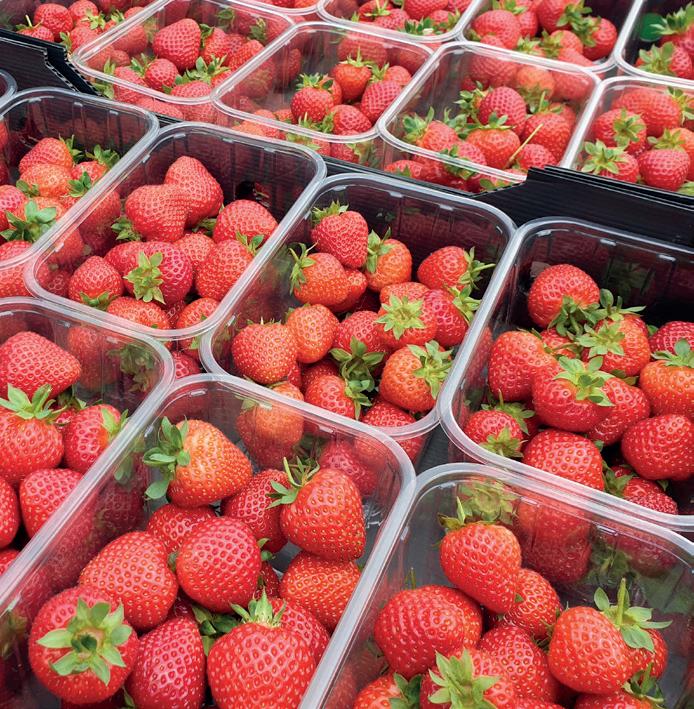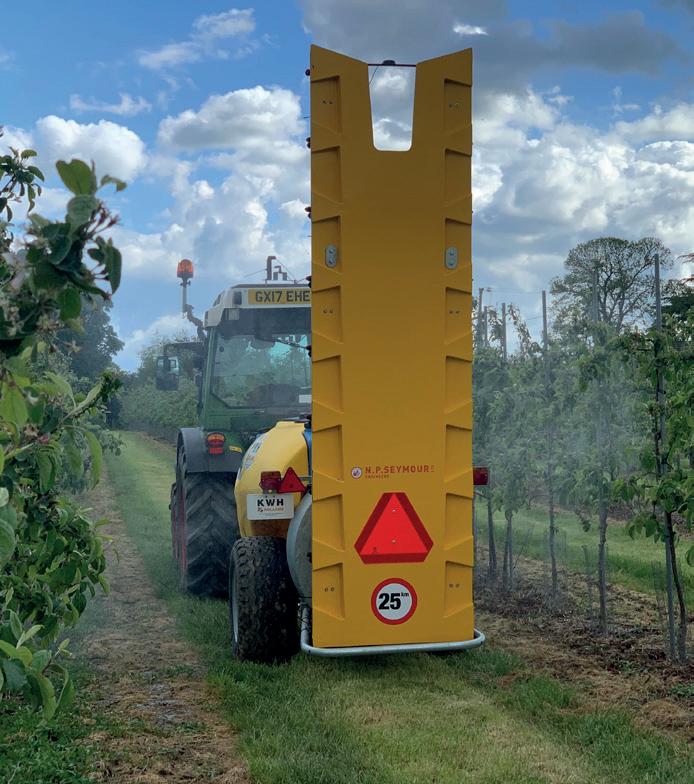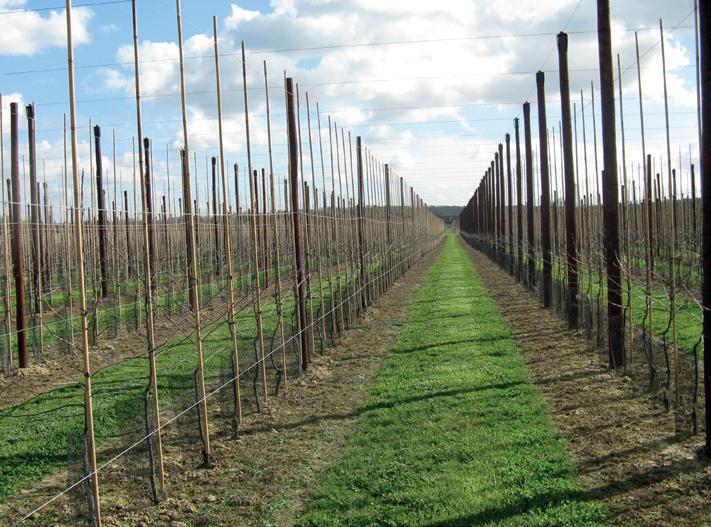
7 minute read
New Projects 2022/23
Eleftheria Stavridou, Senior Specialist in Plant Nutrition
Title: Increasing ascorbic acid and iron levels in tomatoes to enhance human nutrition and plant abiotic stress tolerance
Advertisement
Funder: Growing Kent & Medway
Industry partner: Thanet Earth
Term: May 2022 to October 2024
Hotter drier summers can adversely affect the growth and yield of tomato plants, which have a narrow range of optimal growing temperatures. Heat stress not only limits yield, but has an adverse effect on fruit development and nutritional content. Increased levels of ascorbic acid (vitamin C) and iron levels help tomato to withstand heat stress (pictured). This project seeks to develop ways of enhancing the production of nutrient dense tomatoes, increasing the levels of both vitamin C and iron, providing improved cropping and a higher value product to enhance human health.
Crop Science And Production Systems
Title: Increasing productivity and sustainability in UK viticulture: investigating the potential impact of groundcover management practices on soil health, yields and juice quality, and emissions

Funder: Defra Farming Innovation Programme
Industry partners: Chapel Down, English Wines PLC, Gusbourne Estate Ltd, T. Denne & Sons Ltd, University of Greenwich, Vinescapes Ltd
Term: May 2022 to April 2024
NIAB’s soil scientists are increasingly aware that poor soil health can give rise to inconsistent yields and juice quality in vine growing, which can lead to costly interventions in the vineyard and winery. This project is investigating the potential impact of groundcover management practices on soil health, yields, juice quality and emissions (pictured). It will also lead to grower guidance on bespoke cover crop mixes to alleviate soil compaction, improve soil nutrition and control nematodes. Guidelines to support transition towards net-zero carbon emissions will be drawn up alongside this.
BREEDING
Amanda Karlstrom, Plant Breeder and Geneticist

Title: Enabling marker-based breeding methods for apple crispness
Funder: Horticultural quality and food loss network
Industry partners: University of Greenwich (Natural Resources Institute), WORLDWIDE Fruit Ltd

Term: April 2022 to December 2022
Flavour and fruit texture are the most important fruit characteristics affecting consumer’s liking of apple varieties. Fruit texture is composed of both firmness and crispness and successful post-harvest storage of apples depends on reducing the decline in firmness and crispness to a minimum. In breeding new varieties, apple breeders would benefit from identifying genetic markers which confer high levels of firmness and crispness and this project will help to validate these markers and identify potential breeding parents which can be deployed to improve these quality traits.
Title: Screening for ‘resistance’ to spotted wing drosophila (Drosophila suzukii) in strawberry and raspberry accessions
Funder: Growing Kent & Medway
Industry partner: Asplins Producer Organisation
Term: May 2022 to October 2024
Spotted wing drosophila (SWD – pictured) is an invasive pest of soft and stone fruit that originated in Japan and spread across the world, arriving in the UK in 2012. Since then NIAB entomologists have been engaged on a series of AHDB, government, research council and charity funded projects aimed at reducing the chemical inputs to control SWD. This project is investigating fruit characteristics in strawberry and raspberry that may be associated with ‘resistance’ to SWD and aims to identify germplasm for use in future strawberry and raspberry breeding programmes.

Title: Enhancing orchard ecology for improved resilience to climate change and apple canker disease
Funder: Growing Kent & Medway
Industry partner: Avalon Fresh
Term: May 2022 to October 2024
Apple canker is the highest research priority for UK apple growers, particularly as it can result in up to 10% annual tree losses occurring in young orchards in the early years after establishment. It is particularly damaging in high density planting of highly susceptible varieties. Its impact is also increasing due to climate change. NIAB has benefited from AHDB and BBSRC funding to work on apple canker but control options continue to be expensive, time consuming and can have limited impact. This project will explore novel approaches such as biocontrol, alternative spray programmes and soil amendments for improved tree health and resilience with the hope of improving canker management practices.
Title: Testing field efficacy of spray programmes against apple canker pathogen
Neonectria ditissima using novel plant protection products
Funder: AHDB
Term: May 2022 to June 2023
With limited effective fungicides available for apple canker and the recent loss of copper products for suppressing infection at bud burst and leaf fall, AHDB funded a project to assess novel products as standalone treatments. In its final operating year, the AHDB Horticulture crop protection team has funded NIAB to test combinations of the best performing products from the previous trials, and also include any new products that have become available including new fungicides, biocontrol agents, biostimulants and alternative chemicals (pictured).
Assessing novel products for apple canker control

Pest And Pathogen Ecology
Title: Development of pheromones for innovative management of forest bug, an emerging pest of orchards in England
Funder: Defra Farming Innovation Programme
Partners: Agrovista UK Ltd, Avalon Fresh, Russell IPM, University of Greenwich
Term: May 2022 to April 2024
The forest bug (Pentatoma rufipes) is a new pest of apple and pear in the UK, which has been causing increasing levels of damage since the withdrawal of several broad-spectrum spray products. The bug, which feeds on developing fruitlets causes fruit distortion and can give rise to up to 40% crop losses. Monitoring by tap sampling is time consuming and unpractical. This project aims to identify and synthesise a pheromone for forest bug (pictured), which can then be used as a lure in traps which will allow growers to monitor for the presence of the pest and allow the industry to work towards novel approaches to control.
We aim to identify a sex pheromone for forest bug

Francis Wamonje, Entomology Research Leader
Title: Brown marmorated stink bug (Halyomorpha halys) surveillance in the UK
Funder: Defra
Term: March 2022 to February 2024
Brown marmorated stink bug (BMSB, Halyomorpha halys an invasive pest established in many European countries, causing significant crop damage in apples and pears in countries such as Italy, where temperatures favour two generations per year. NIAB has been monitoring since 2018 and has observed adults, more recently females, free in the environment within England. In this project we will continue to monitor for adults in the environment (pictured), search for immature stages to determine if populations are establishing in the UK, intercept BMSB emerging from overwintering sites and collate expert confirmed public findings.
Pest And Pathogen Ecology
Surveillance for populations of brown marmorated stink bug

Title: Apple Sawfly: Developing extraction methods to acquire adult insects for pheromone identification
Funder: The Worshipful Company of Fruiterers
Term: February 2023 to December 2023
Apple sawfly larvae can cause serious damage (pictured) if left uncontrolled in apple orchards. With the loss of several broad-spectrum spray products and a period of activity that coincides with blossom when conservation of pollinating insects is vital, alternative control measures are needed.

Previous attempts to identify the sex pheromone have been hampered by an inability to rear sufficient numbers, so this project will focus on methods of collecting and rearing sufficient apple sawfly adults to allow pheromone identification, which might lead to future development of novel monitoring and control tools.

Title: Agrobioconnect: Connections in the landscape. Role of landscape complexity in agroecosystem sustainability
Funder: Defra SusCrop ERA-Net
Partners: Berry Gardens Growers and Avalon Fresh
Term: February 2023 to January 2026
Intensive horticultural practices can lead to unsustainable activities which exacerbate damage to the environment. Increased biodiversity can lead to more resilient ecosystems, but requires a holistic understanding of the ecological mechanisms at work. Working within a European science partnership, NIAB will study the landscape complexity across 18 commercial UK fruit farms, attempting to assess the impact on arthropod abundance including beneficials like predators, parasitoids and pollinators. The findings will guide policy and actions on fruit farms to adapt to climate change.
Title: Advanced optical tomography tools for non-destructive detection of latent fungal infection in produce
Funder: Biotechnology and Biological Sciences Research Council
Partners: University of Kent
Term: April 2023 to June 2024
Two thirds of food waste occurs after harvest, much of it being lost through latent infections which can only be detected using destructive techniques which are expensive and time consuming. A non-destructive method would allow the industry to detect latent infections before fruit is loaded into store, where infection spreads rapidly. Fruit with latent infection could be marketed early, while fruit without infection could be stored with confidence for longer durations. This project aims to develop a new non-destructive imaging tool that will detect latent infections of brown rot on cherry before it is loaded into store (pictured).
PEST AND PATHOGEN ECOLOGY
Can we develop a non-destructive tool for identifying latent brown rot in harvested cherry?

Title: Assessing the biocontrol effect of coir adapted beneficial microbes on Phytophthora root diseases in berry production
Funder: The Worshipful Company of Fruiterers
Term: January 2023 to September 2023
Phytophthora pathogens can be highly destructive in strawberry and raspberry crops. The soft fruit industry now has very limited chemical control options available and biocontrol options have had mixed success, in part because they do not always establish well in coir substrate. NIAB scientists have isolated strains of Bacillus, Pseudomonas and Streptomyces species from commercially grown healthy strawberry and raspberry crops which could offer beneficial effects. In this project, they will be assessed for their biocontrol potential both in vitro and in semi-commercial trials.
Title: Predicting the emergence of host-adapted bacterial phytopathogens
Funder: Biotechnology and Biological Sciences Research Council, Defra, NERC and the Scottish Government
Partners: University of Birmingham and Imperial College
Term: July 2020 to March 2024
Bacterial pathogens can cause significant commercial damage and in the case of cherry, Pseudomonas syringae (pathovars syringae and morsprunorum) can cause up to 70% tree loss. Cherry growers have recently lost the use of copper based control sprays, so new forms of management are required. This project aims to provide fundamental insights into how new strains of pathogens emerge and evolve on potential hosts using Pseudomonas syringae as an example. It will lead to improved design of disease management methods and new precision tools for assessing risks.
Title: Using end of season biocontrol to reduce crown rot in reused coir bags
Funder: Defra
Term: October 2022 to March 2023
Phytophthora cactorum (pictured) can contribute to reduced yields in strawberry plants established in reused coir bags. With few effective conventional fungicides available, growers may resort to biofungicides, but we need more information about their efficacy. NIAB scientists are infecting pots of both virgin and spent coir with Phytophthora cactorum, then applying five commercially available biofungicides at the end of the growing season, incubating them for 1 month, then planting the pots with clean strawberry plants. To assess the efficacy of each, the plants will be assessed both visually and using molecular analysis 12 weeks after planting.

PEST AND PATHOGEN
Ecology
Title: Biocontrol of horticultural diseases in apple and strawberry using cover crops and biopesticides

Funder: EU ERA-NET (Defra)
Term: April 2021 to March 2024
One part of this project is investigating the use of biological control agents (BCAs) to improve their efficacy for disease control in strawberry. Commercial use of BCAs in strawberry has mixed results and is often less reliable than conventional fungicides. However, understanding their population dynamics relative to climatic conditions can be crucial to their efficacy. NIAB is working on three BCAs commonly used in strawberry to obtain ecological knowledge and to develop models to predict their fate in the environment following their application, so that we can optimise the timing of their use.









